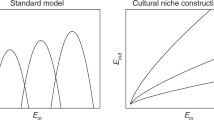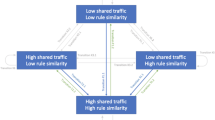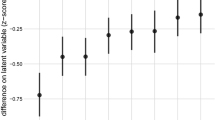Abstract
Organizations devoted to the production of goods and services, such as guilds, partnerships and modern corporations, have dominated the economic landscape in our species’ history. We develop an explanation for their evolution drawing from cultural evolution theory. A basic tenet of this theory is that social learning, under certain conditions, allows for the diffusion of innovations in society and, therefore, the accumulation of culture. Our model shows that these organizations provide such conditions by possessing two characteristics, both prevalent in real world organizations: exclusivity of membership and more effective social learning within their boundaries. The model and its extensions parsimoniously explain the cooperative nature of the social learning advantage, organizational specialization, organizational rigidity and the locus of innovation. We find supportive evidence for our predictions using a sample of premodern societies drawn from the Ethnographic Atlas. Understanding the nature of these organizations informs the debate about their role in society.
This is a preview of subscription content, access via your institution
Access options
Access Nature and 54 other Nature Portfolio journals
Get Nature+, our best-value online-access subscription
$29.99 / 30 days
cancel any time
Subscribe to this journal
Receive 12 digital issues and online access to articles
$119.00 per year
only $9.92 per issue
Buy this article
- Purchase on Springer Link
- Instant access to full article PDF
Prices may be subject to local taxes which are calculated during checkout



Similar content being viewed by others
Data availability
The source data used in this paper is publicly available at https://d-place.org/. The dataset used in this paper is available at https://sites.google.com/site/fcobrahm/.
Code availability
The code used to analyse the data is available at https://sites.google.com/site/fcobrahm/.
References
Scott, R. Organizations: Rational, Natural and Open Systems 5th edn (Prentice Hall, 2003).
Hansmann, H., Kraakman, R. & Squire, R. Law and the rise of the firm. Harv. Law Rev. 119, 1335–1403 (2006).
Epstein, S. R. Craft guilds, apprenticeship, and technological change in preindustrial Europe. J. Economic Hist. 58, 684–713 (1998).
Padgett, J. F. & McLean, P. D. Organizational invention and elite transformation: the birth of partnership systems in renaissance florence. Am. J. Sociol. 111, 1463–1568 (2006).
Chandler, A. D. Scale and Scope: The Dynamics of Industrial Competition (Harvard Business School Press, 1990).
Simon, H. A. Organizations and markets. J. Econ. Perspect. 5, 25–44 (1991).
Friedman, M. The social responsibility of business is to increase its profits. New York Times Magazine 13, 122–126 (1970).
Freeman, R. E. Strategic Management: A Stakeholder Approach (Cambridge Univ. Press, 2010).
Cavalli-Sforza, L. & Feldman, M. W. Cultural Transmission and Evolution: A Quantitative Approach (Princeton Univ. Press, 1981).
Boyd, R. & Richerson, P. J. Culture and the Evolutionary Process (Univ. Chicago Press, 1985).
Boyd, R. & Richerson, P. J. The Origin and Evolution of Cultures (Oxford Univ. Press, 2005).
Mesoudi, A., Cultural Evolution: How Darwinian Theory Can Explain Human Culture and Synthesize the Social Sciences (Univ. Chicago Press, 2011).
Henrich, J. The Secret of Our Success: How Culture is Driving Human Evolution, Domesticating our Species, and Making us Smarter (Princeton Univ. Press, 2016).
Laland, K. Darwin’s Unfinished Symphony: How Culture Made the Human Mind (Princeton Univ. Press, 2017)
Smolla, M. & Akçay, E. Cultural selection shapes network structure. Sci. Adv. 5, eaaw0609 (2019).
Migliano, A. B. et al. Hunter-gatherer multilevel sociality accelerates cumulative cultural evolution. Sci. Adv. 6, eaax5913 (2020).
Cordes, C., Richerson, P. J., McElreath, R. & Strimling, P. A naturalistic approach to the theory of the firm: the role of cooperation and cultural evolution. J. Economic Behav. Organ. 68, 125–139 (2008).
Richerson, P. J., Collins, D. & Genet, R. M. Why managers need an evolutionary theory of organizations. Strategic Organ. 4, 201–211 (2006).
Coase, R. The nature of the firm. Economica 4, 386–405 (1937).
Hart, O. & Moore, J. Property rights and the nature of the firm. J. Political Econ. 98, 1119–1158 (1990).
Williamson, O. E. Markets and Hierarchies (Free Press, 1975).
Williamson, O. E. Comparative economic organization: the analysis of discrete structural alternatives. Adm. Sci. Q. 36, 269–296 (1991).
Tadelis, S. Complexity, flexibility, and the make-or-buy decision. Am. Economic Rev. 92, 433–437 (2002).
Holmstrom, B. & Milgrom, P. The firm as an incentive system. Am. Economic Rev. 84, 972–991 (1994).
Lafontaine, F. & Slade, M. Vertical integration and firm boundaries: the evidence. J. Economic Lit. 45, 629–685 (2007).
Atalay, E., Hortaçsu, A. & Syverson, C. Vertical integration and input flows. Am. Economic Rev. 104, 1120–1148 (2014).
Argote, L. & Miron-Spektor, E. Organizational learning: from experience to knowledge. Organ. Sci. 22, 1123–1137 (2011).
Gibbons, R. & Henderson, R. Relational contracts and organizational capabilities. Organ. Sci. 23, 1350–1364 (2012).
De la Croix, D., Doepke, M. & Mokyr, J. Clans, guilds, and markets: apprenticeship institutions and growth in the pre-industrial economy. Q. J. Econ. 133, 1–70 (2018).
Morrison, A. D. & Wilhelm, W. J. The demise of investment banking partnerships: theory and evidence. J. Financ. 63, 311–350 (2018).
Barnard, C. The Functions of the Executive (Harvard Univ. Press, 1938).
Schein, E. H. Organizational Culture and Leadership 4th edn (John Wiley & Sons, 2010).
Podsakoff, N. P., Whiting, S. W., Podsakoff, P. M. & Blume, B. D. Individual-and organizational-level consequences of organizational citizenship behaviors: a meta-analysis. J. Appl. Psychol. 94, 122–141 (2009).
Kogut, B. & Zander, U. What firms do? Coordination, identity, and learning. Organ. Sci. 7, 502–518 (1996).
Baker, G., Gibbons, R. & Murphy, K. J. Relational contracts and the theory of the firm. Q. J. Econ. 117, 39–84 (2002).
Fogarty, L., Strimling, P. & Laland, K. N. The evolution of teaching. Evolution 65, 2760–2770 (2011).
Dean, L. G., Kendal, R. L., Schapiro, S. J., Thierry, B. & Laland, K. N. Identification of the social and cognitive processes underlying human cumulative culture. Science 335, 1114–1118 (2012).
Laland, K. N., Sterelny, K., Odling-Smee, J., Hoppitt, W. & Uller, T. Cause and effect in biology revisited: is Mayr’s proximate-ultimate dichotomy still useful? Science 334, 1512–1516 (2011).
Bateson, P. & Laland, K. N. Tinbergen’s four questions: an appreciation and an update. Trends Ecol. Evolution 28, 712–718 (2013).
Boyd, R. A Different Kind of Animal: How Culture Transformed Our Species (Princeton Univ. Press, 2018).
Boyd, R., Richerson, P. J. & Henrich, J. The cultural evolution of technology: facts and theories. in Cultural Evolution: Society, Technology, Language, and Religion (eds Richerson, P. J. and Christiansen, M. H.) 119–142 (2013).
Mayr, E. Cause and effect in biology. Science 134, 1501–1506 (1961).
Elster, J. Explaining Technical Change: A Case Study in the Philosophy of Science (Cambridge Univ. Press, 1983).
Nelson, R. R. & Winter, S. G. An Evolutionary Theory of Economic Change (Belknap Harvard, 1982).
Dari-Mattiacci, G., Gelderblom, O., Jonker, J. & Perotti, E. The emergence of the corporate form. J. Law, Econ. Organ. 33, 193–236 (2017).
Giuliano P., & Nunn, N. Understanding cultural persistence and change. Rev. Econ. Stud. (in the press).
Gray, R. D. & Watts, J. Cultural macroevolution matters. Proc. Natl Acad. Sci. USA 114, 7846–7852 (2017).
Coto-Sarmiento, M., Rubio-Campillo, X. & Remesal, J. Identifying social learning between Roman amphorae workshops through morphometric similarity. J. Archeological Sci. 96, 117–123 (2018).
Smith, A. The Wealth of Nations (W. Strahan and T. Cadell, 1776)
Becker, G. S. & Murphy, K. M. The division of labor, coordination costs, and knowledge. Q. J. Econ. 107, 1137–1160 (1992).
Ricardo, D. On the Principles of Political Economy and Taxation (John Murray, 1817).
Sterelny, K. The Evolved Apprentice: How Evolution Made Humans Unique (MIT Press, 2012).
Rogers, A. R. Does biology constrain culture? Am. Anthropol. 90, 819–831 (1988).
Boyd, R. & Richerson, P. J. Why does culture increase human adaptability? Ethol. Sociobiol. 16, 125–143 (1995).
Apel, J. Knowledge, know-how and raw material: the production of Late Neolithic flint daggers in Scandinavia. J. Archaeol. Meth. Theory 15, 91–111 (2008).
Smith, D., Stebbins, R., & Grotz, J. The Palgrave Handbook of Volunteering, Civic Participation, and Nonprofit Associations (Palgrave McMillan, 2016).
Anderson, R. Voluntary associations in history. Am. Anthropol. 73, 209–222 (1971).
Lowie, R. Social Organization (Rinehart and Co., 1948)
Nowak, M. A. Five rules for the evolution of cooperation. Science 314, 1560–1563 (2006).
Rand, D. G. & Nowak, M. A. Human cooperation. Trends Cogn. Sci. 17, 413–425 (2013).
Bowles, S. Did warfare among ancestral hunter-gatherers affect the evolution of human social behaviors? Science 324, 1293–1298 (2009).
Richerson, P. et al. Cultural group selection plays an essential role in explaining human cooperation: a sketch of the evidence. Behav. Brain Sci. 39, e30 (2016).
Sober, E., & Wilson, D. S. Unto Others: The Evolution and Psychology of Unselfish Behavior (Harvard Univ. Press, 1999).
Nickerson, J. & Zenger, T. A knowledge-based theory of the firm–the problem solving perspective. Organ. Sci. 15, 617–632 (2004).
Henrich, J. Cultural group selection, coevolutionary processes and large-scale cooperation. J. Econ. Behav. Organ. 53, 3–35 (2004).
Levitt, S. D., List, J. A. & Syverson, C. Toward an understanding of learning by doing: evidence from an automobile assembly plant. J. Political Econ. 121, 643–681 (2013).
Buchanan, J. An economic theory of clubs. Economica 32, 1–14 (1965).
Anderson, G. M., Shughart, W. F., & Tollison, R. D. in The Encyclopedia of Public Choice (eds Rowley, C. & Schneider, F.) 499–504 (Springer, 2004).
Sandler, T. & Tschirhart, J. Club theory: thirty years later. Public Choice 93, 335–355 (1997).
Arora, A., Cohen, W. & Cunningham, C. Inventive Capabilities in the Division of Innovative Labor Working Paper No. 25051 (NBER, 2018).
Henderson, R. Underinvestment and incompetence as responses to radical innovation: evidence from the photolithographic alignment equipment industry. RAND J. Econ. 24, 248–279 (1993).
Tripsas, M. & Gavetti, G. Capabilities, cognition, and inertia: evidence from digital imaging. Strategic Manag. J. 21, 1147–1161 (2000).
Ward, Benjamin The firm in Illyria: market syndicalism. Am. Economic Rev. 48, 566–589 (1958).
Gustafsson, B. The rise and economic behavior of medieval craft guilds: an economic-theoretical interpretation. Scand. Economic Hist. Rev. XXXV, 1–40 (1987).
Spulber, D. F. The Theory of the Firm: Microeconomics with Endogenous Entrepreneurs, Firms, Markets, and Organizations (Cambridge Univ. Press, 2009)
Hoppitt, W. & Laland, K. N. Social Learning: An Introduction to Mechanisms, Methods, and Models (Princeton Univ. Press, 2013).
Cohen, W. M. & Levinthal, D. A. Absorptive capacity: a new perspective on learning and innovation. Admin. Sci. Quart. 35, 128–152 (1990).
Gross, D. The Consequences of Invention Secrecy: Evidence from the USPTO Patent Secrecy Program in World War II Working Paper No. 25545 (NBER, 2020).
Kendal, J., Giraldeau, L. A. & Laland, K. The evolution of social learning rules: payoff-biased and frequency-dependent biased transmission. J. Theor. Biol. 260, 210–219 (2009).
Boyd, R. & Richerson, P. J. Culture and the evolution of human cooperation. Phil. Trans. R. Soc. B: Biol. Sci. 364, 3281–3288 (2009).
Turchin, P. Ultra-Society: How 10,000 Years of War Made Humans the Greatest Cooperators on Earth (Beresta Books, 2016).
Murdock, G. P. Ethnographic Atlas (Univ. Pittsburgh Press, 1967).
Kirby, K. et al. D-PLACE: a global database of cultural, linguistic and environmental diversity. PLoS ONE 11, e0158391 (2016).
Oster, E. Unobservable selection and coefficient stability: theory and evidence. J. Bus. Economic Stat. 37, 187–204 (2016).
Comino, S., Galasso, A. & Clara Graziano, C. Market power and patent strategies: evidence from Renaissance Venice. J. Ind. Econ. 68, 226–269 (2020).
Acknowledgements
J.P. gratefully acknowledges research support from ANID grant no. PIA/APOYO AFB180003 and Instituto Milenio grant no. MIPP IS130002. We acknowledge comments provided by M. Feldman, P. Richerson, C. Loch, S. Kavadias, B. Silverman, J. Peck, A. Feylessoufi, R. Bojilov, E. Depetris-Chauvin, R. Alonso, J. Tessada, A. Goldberg, S. Ethiraj, E. Papaioannu, B. Vanneste, V. Mak and T. Waring; by seminar participants at the Judge Business School, Stanford Business School, the London Business School and by participants at the Second Annual Meeting of the Cultural Evolution Society, Seventh Toulouse Economics and Biology Workshop, Annual Society for Institutional and Organizational Economics Conference (SIOE), Cambridge Clare Hall Graduate Students Conference, Third Culture Conference at the University of Birmingham, the Institute for Operations Research and Management Science Annual Meeting (INFORMS), the Winter Cambridge Judge Business School PhD Conference, the Sixth Development Workshop at the Catholic University of Chile, the inaugural Strategy Science Conference, Barcelona Graduate School of Economics Summer Forum (Organizational Economics) and the Trento Summer School on ‘New Thinking on the Firm: Perspectives from Law, Economics, Organization, and History’.
Author information
Authors and Affiliations
Contributions
F.B. and J.P. conceived the study. J.P. did most of the mathematical models, reviewed the empirical analysis and reviewed and edited the text. F.B. reviewed and contributed with some of the mathematical models, executed the model simulations and associated figures, wrote most of the text and executed the empirical analysis and its associated figures and tables.
Corresponding author
Ethics declarations
Competing interests
The authors declare no competing interests.
Additional information
Peer review information Peer review reports are available. Primary handling editor: Charlotte Payne.
Publisher’s note Springer Nature remains neutral with regard to jurisdictional claims in published maps and institutional affiliations.
Supplementary information
Supplementary Information
Supplementary Note, Supplementary Figs. 1–12 and Supplementary Tables 1–13.
Rights and permissions
About this article
Cite this article
Brahm, F., Poblete, J. The evolution of productive organizations. Nat Hum Behav 5, 39–48 (2021). https://doi.org/10.1038/s41562-020-00957-x
Received:
Accepted:
Published:
Issue Date:
DOI: https://doi.org/10.1038/s41562-020-00957-x



